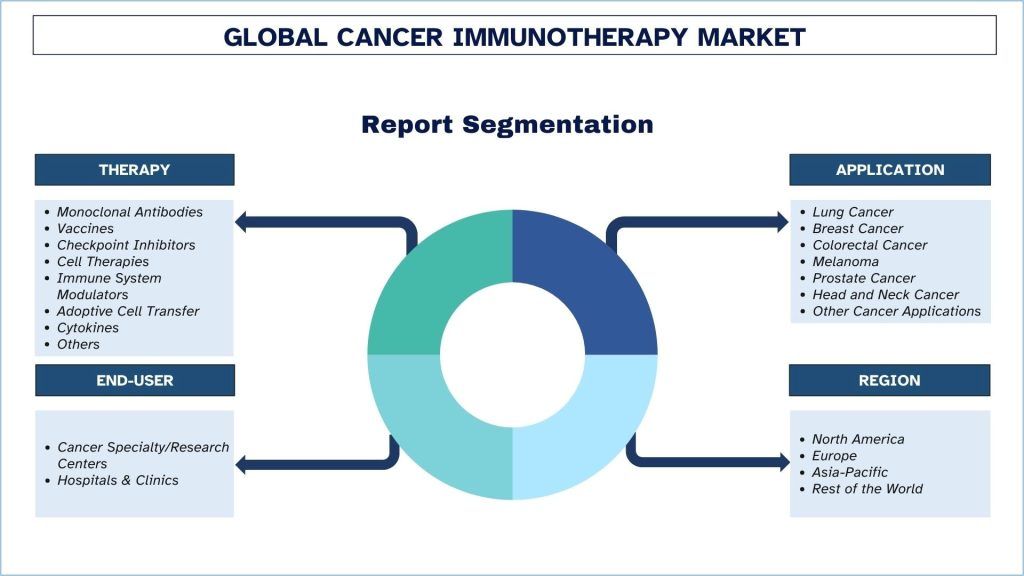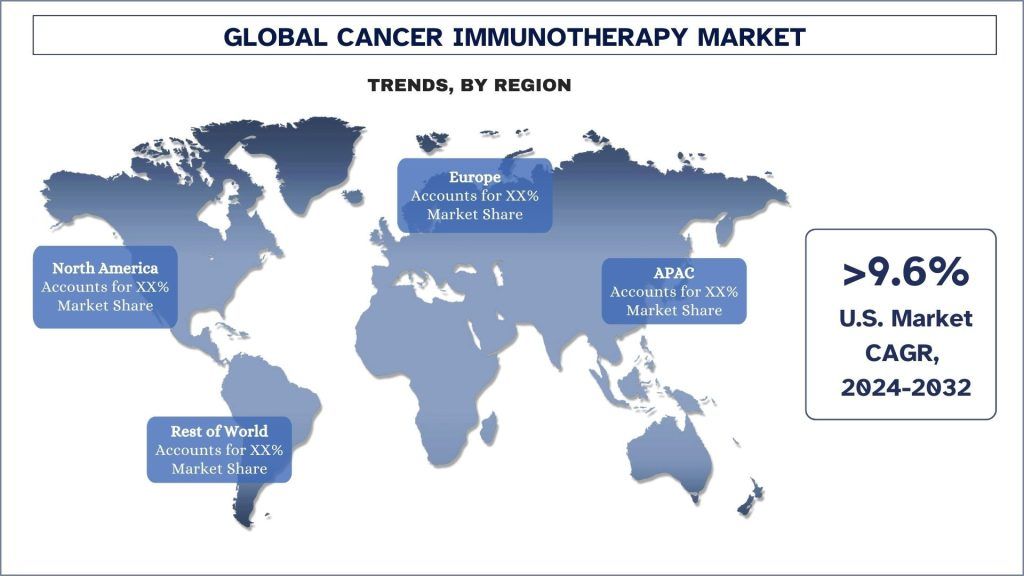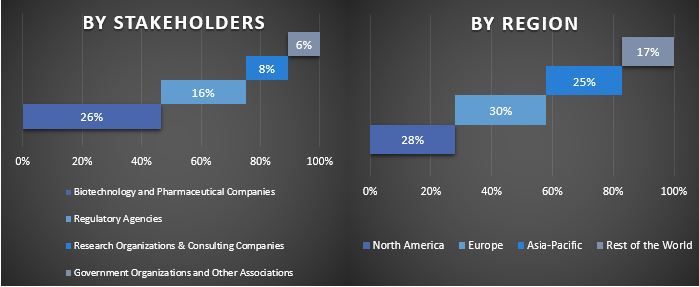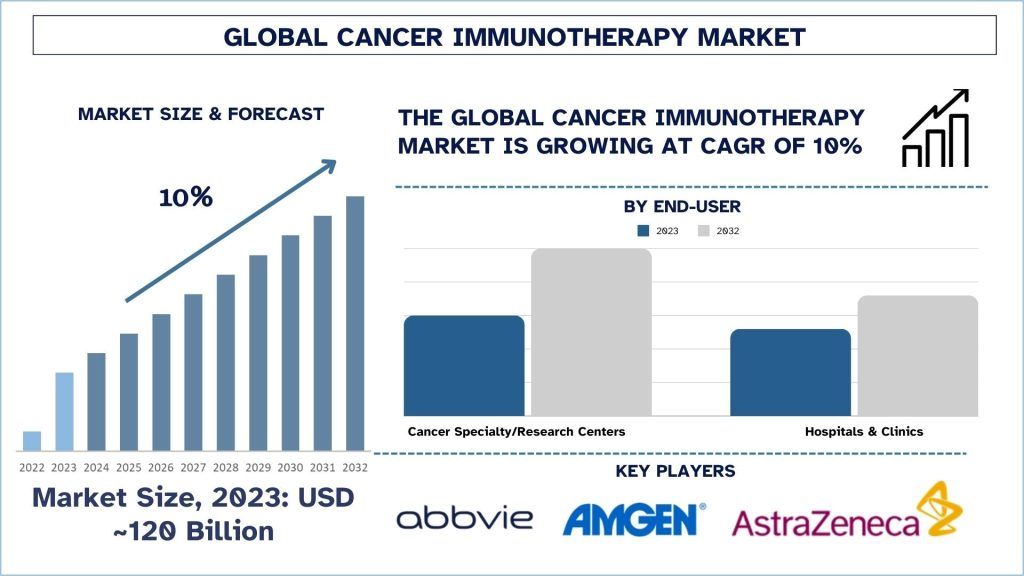- Home
- About Us
- Industry
- Services
- Reading
- Contact Us
Cancer Immunotherapy Market: Current Analysis and Forecast (2024-2032)
Emphasis on Therapy Type (Monoclonal Antibodies, Vaccines, Checkpoint Inhibitors, Cell Therapies, Immune System Modulators, Adoptive Cell Transfer, Cytokines, and Others), Application (Lung cancer, Breast cancer, Colorectal cancer, Melanoma, Prostate cancer, Head and neck cancer, Others), End-User (Cancer Specialty/Research Centers, Hospitals & Clinics), and Region/Country
Cancer Immunotherapy Market Size & Forecast
The Cancer Immunotherapy market was valued at approximately USD 120 billion in 2023 and is expected to grow at a substantial CAGR of around 10% during the forecast period (2024-2032) owing to the rising number of cancer cases globally.
Cancer Immunotherapy Market Analysis
Cancer Immunotherapy is a branch of cancer treatment that combines the body’s immune system to identify, attack, and kill cancer. Whereas chemotherapy and radiation are geared toward a direct approach to killing cancer cells, immunotherapy helps the body’s immune system to work more effectively in combating the disease. This strategy involves several processes; checkpoint inhibitors, CAR-T cell therapies, and cancer vaccines, and will be more effective than conventional therapies, providing long-term solutions, and little or no side effects.
Cancer immunotherapy companies are employing several strategies to sustain growth some of these are branching out to different cancer indications including solid tumors and using cancer immunotherapy in combination with other existing cancer treatments. They are also greatly focusing on immunotherapy innovation to produce new products including bispecific antibodies and the following generation of CAR-T. For instance, on May 23, 2024, Regeneron Pharmaceuticals, Inc. announced positive new results from an ongoing Phase 1/2 trial evaluating its first-in-class costimulatory bispecific antibody, REGN7075 (EGFRxCD28), in combination with Libtayo (cemiplimab) in patients with advanced solid tumors. In addition, there are huge adoption of artificial intelligence in treatment and drug development, new business models of strategic partnerships, and collaborations to improve pipeline and global market reach.
Cancer Immunotherapy Market Trends
This section discusses the key market trends influencing the various segments of the Cancer Immunotherapy market as identified by our research experts.
Checkpoint Inhibitors Segment Transforms Cancer Immunotherapy Industry
Checkpoint Inhibitors segment is a significant driver of the Cancer Immunotherapy market since it offers best-in-class results with a variety of cancers such as melanoma, and lung and kidney cancer. These drugs are given by targeting proteins that mask cancer cells from being attacked by the immune system, including PD-1, PD-L1, and CTLA-4. These ‘checkpoints’ regulate the immune response to allow cancer cells to grow unimpeded; checkpoint inhibitors, therefore, assist the immune system in identifying and eliminating cancer cells. These targets have exhibited a high rate of success in clinical trials resulting in raising the number of regulatory approvals hence the demand for these therapies. Moreover, constant research is being done to introduce them to other kinds of cancer and to sync them with chemotherapy, radiation, or other immunotherapies, all of which are increasing their market share. For instance, in August 2024, Merck announced that PD-L1 expression thresholds for certain advanced gastric, gastroesophageal junction (GEJ) and esophageal cancer indications for immune checkpoint inhibitors, including KEYTRUDA (pembrolizumab), Merck’s anti-PD-1 therapy, will be discussed during an upcoming meeting of the U.S. Food and Drug Administration’s (FDA) Oncologic Drugs Advisory Committee (ODAC). The expansion of the segment is also backed by increasing investment in the development of new drugs and the detection of biomarkers to better define treatment options, further boosting the space’s demand.

North America leads the market.
North America has the most advanced healthcare systems, especially in the United States, which has set the pace in the growth and adoption of cancer immunotherapy due to the rapid economic development of the country and high investment in research and development and adoption of modern therapies. The region has experienced growth over the past few years as more approvals are being granted to new immunotherapies such as checkpoint inhibitors and CAR-T cell therapies. Pioneering companies in the field include Bristol-Myers Squibb, Merck, and Pfizer already developing several drugs such as Keytruda and Opdivo that have already become popular. For instance, on March 6, 2024, the Food and Drug Administration approved nivolumab (Opdivo, Bristol-Myers Squibb Company) in combination with cisplatin and gemcitabine for first-line treatment of adult patients with unresectable or metastatic urothelial carcinoma (UC). There are also new government activities for change in the healthcare industry along with favorable reimbursement policies that are also driving the growth of the market. Moreover, North America is emphasizing biomarkers-based individualized immunotherapy and it is improving the results of the treatment. However, other factors such as increased incidences of cancer, enhanced patient awareness, and availability of novel therapies also catalyze the speedy uptake of cancer immunotherapies specifically in the North American region that is expected to be the future growth hub of this segment.

Cancer Immunotherapy Industry Overview
The Cancer Immunotherapy market is competitive, with several global and international players. The key players are adopting different growth strategies to enhance their market presence, such as partnerships, agreements, collaborations, new product launches, geographical expansions, and mergers and acquisitions. Some of the major players operating in the market are AbbVie Inc., Amgen Inc., AstraZeneca, Bluebird Bio, Inc., Bristol-Myers Squibb Company, F. Hoffmann-La Roche Ltd, Janssen Global Services, LLC, Merck & Co., Inc., Novartis AG, Pfizer Inc.
Cancer Immunotherapy Market News
- September 12, 2024, Sanofi, RadioMedix, and Orano Med announced a licensing agreement on next-generation radioligand medicine for rare cancers.
- August 2024 – Merck announced that PD-L1 expression thresholds for certain advanced gastric, gastroesophageal junction (GEJ), and esophageal cancer indications for immune checkpoint inhibitors, including KEYTRUDA (pembrolizumab), Merck’s anti-PD-1 therapy, will be discussed during an upcoming meeting of the U.S. Food and Drug Administration’s (FDA) Oncologic Drugs Advisory Committee (ODAC).
- August 2022 – Bristol Myers Squibb announced that OpdualagTM (nivolumab and relatlimab-rmbw), a new, first-in-class, fixed-dose combination of nivolumab and relatlimab, administered as a single intravenous infusion, was approved by the U.S. Food and Drug Administration (FDA) for the treatment of adult and pediatric patients 12 years of age or older with unresectable or metastatic melanoma.1 The approval is based on the Phase 2/3 RELATIVITY-047 trial, which compared Opdualag (n=355) to nivolumab alone (n=359).
Cancer Immunotherapy Market Report Coverage

Reasons to buy this report:
- The study includes market sizing and forecasting analysis validated by authenticated key industry experts.
- The report presents a quick review of overall industry performance at one glance.
- The report covers an in-depth analysis of prominent industry peers with a primary focus on key business financials, product portfolios, expansion strategies, and recent developments.
- Detailed examination of drivers, restraints, key trends, and opportunities prevailing in the industry.
- The study comprehensively covers the market across different segments.
- Deep dive regional level analysis of the industry.
Customization Options:
The global Cancer Immunotherapy market can be customized further as per the requirement or any other market segment. Besides this, UMI understands that you may have your own business needs, hence feel free to connect with us to get a report that completely suits your requirements.
Table of Content
Research Methodology for the Cancer Immunotherapy Market Analysis (2022-2032)
Analyzing the historical market, estimating the current market, and forecasting the future market of the global Cancer Immunotherapy market were the three major steps undertaken to create and analyze the adoption of Cancer Immunotherapy in major regions globally. Exhaustive secondary research was conducted to collect the historical market numbers and estimate the current market size. Secondly, to validate these insights, numerous findings and assumptions were taken into consideration. Moreover, exhaustive primary interviews were also conducted, with industry experts across the value chain of the global Cancer Immunotherapy market. Post assumption and validation of market numbers through primary interviews, we employed a top-down/bottom-up approach to forecasting the complete market size. Thereafter, market breakdown and data triangulation methods were adopted to estimate and analyze the market size of segments and sub-segments of the industry. Detailed methodology is explained below:
Analysis of Historical Market Size
Step 1: In-Depth Study of Secondary Sources:
A detailed secondary study was conducted to obtain the historical market size of the Cancer Immunotherapy market through company internal sources such as annual reports & financial statements, performance presentations, press releases, etc., and external sources including journals, news & articles, government publications, competitor publications, sector reports, third-party database, and other credible publications.
Step 2: Market Segmentation:
After obtaining the historical market size of the Cancer Immunotherapy market, we conducted a detailed secondary analysis to gather historical market insights and share for different segments & sub-segments for major regions. Major segments are included in the report as therapy, application, end-user, and regions. Further country-level analyses were conducted to evaluate the overall adoption of testing models in that region.
Step 3: Factor Analysis:
After acquiring the historical market size of different segments and sub-segments, we conducted a detailed factor analysis to estimate the current market size of the Cancer Immunotherapy market. Further, we conducted factor analysis using dependent and independent variables such as therapy, application, end-user, and regions of the Cancer Immunotherapy market. A thorough analysis was conducted for demand and supply-side scenarios considering top partnerships, mergers and acquisitions, business expansion, and product launches in the Cancer Immunotherapy market sector across the globe.
Current Market Size Estimate & Forecast
Current Market Sizing: Based on actionable insights from the above 3 steps, we arrived at the current market size, key players in the global Cancer Immunotherapy market, and market shares of the segments. All the required percentage shares split and market breakdowns were determined using the above-mentioned secondary approach and were verified through primary interviews.
Estimation & Forecasting: For market estimation and forecast, weights were assigned to different factors including drivers & trends, restraints, and opportunities available for the stakeholders. After analyzing these factors, relevant forecasting techniques i.e., the top-down/bottom-up approach were applied to arrive at the market forecast for 2032 for different segments and sub-segments across the major markets globally. The research methodology adopted to estimate the market size encompasses:
- The industry’s market size, in terms of revenue (USD) and the adoption rate of the Cancer Immunotherapy market across the major markets domestically
- All percentage shares, splits, and breakdowns of market segments and sub-segments
- Key players in the global Cancer Immunotherapy market in terms of products offered. Also, the growth strategies adopted by these players to compete in the fast-growing market
Market Size and Share Validation
Primary Research: In-depth interviews were conducted with the Key Opinion Leaders (KOLs) including Top Level Executives (CXO/VPs, Sales Head, Marketing Head, Operational Head, Regional Head, Country Head, etc.) across major regions. Primary research findings were then summarized, and statistical analysis was performed to prove the stated hypothesis. Inputs from primary research were consolidated with secondary findings, hence turning information into actionable insights.
Split of Primary Participants in Different Regions

Market Engineering
The data triangulation technique was employed to complete the overall market estimation and to arrive at precise statistical numbers for each segment and sub-segment of the global Cancer Immunotherapy market. Data was split into several segments and sub-segments after studying various parameters and trends in the therapy, application, end-user, and regions of the global Cancer Immunotherapy market.
The main objective of the Global Cancer Immunotherapy Market Study
The current & future market trends of the global Cancer Immunotherapy market were pinpointed in the study. Investors can gain strategic insights to base their discretion for investments on the qualitative and quantitative analysis performed in the study. Current and future market trends determined the overall attractiveness of the market at a regional level, providing a platform for the industrial participant to exploit the untapped market to benefit from a first-mover advantage. Other quantitative goals of the studies include:
- Analyze the current and forecast market size of the Cancer Immunotherapy market in terms of value (USD). Also, analyze the current and forecast market size of different segments and sub-segments.
- Segments in the study include areas of the therapy, application, end-user, and regions.
- Define and analyze the regulatory framework for the Cancer Immunotherapy
- Analyze the value chain involved with the presence of various intermediaries, along with analyzing customer and competitor behaviors of the industry.
- Analyze the current and forecast market size of the Cancer Immunotherapy market for the major region.
- Major countries of regions studied in the report include Asia Pacific, Europe, North America, and the Rest of the World
- Company profiles of the Cancer Immunotherapy market and the growth strategies adopted by the market players to sustain the fast-growing market.
- Deep dive regional level analysis of the industry
Frequently Asked Questions FAQs
Q1: What is the Cancer Immunotherapy market's current size and growth potential?
Q2: What are the driving factors for the growth of the Cancer Immunotherapy market?
Q3: Which segment has the largest share of the Cancer Immunotherapy market by therapy?
Q4: What are the major trends in the Cancer Immunotherapy market?
Q5: Which region will dominate the Cancer Immunotherapy market?
Related Reports
Customers who bought this item also bought











